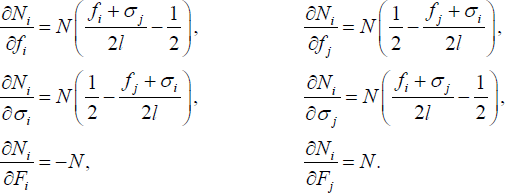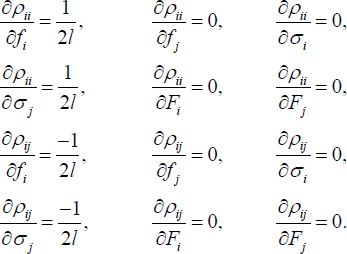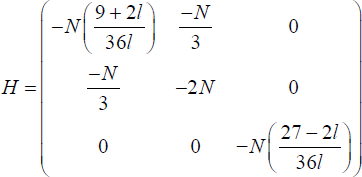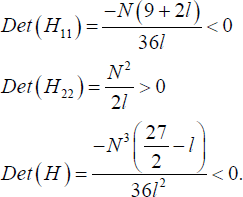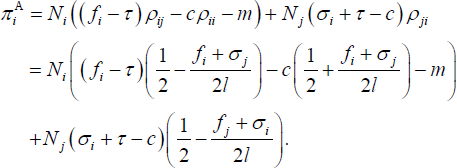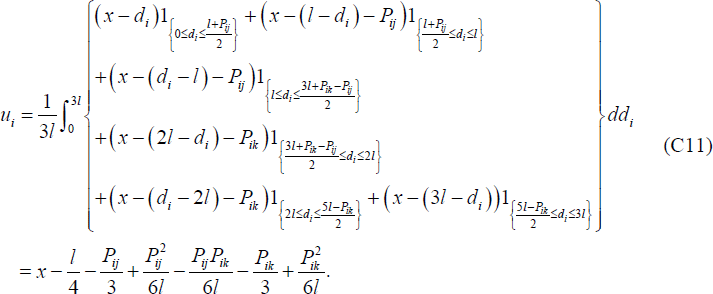RDP 2012-03: ATM Fees, Pricing and Consumer Behaviour: An Analysis of ATM Network Reform in Australia Appendix C: Derivation of Results
August 2012 – ISSN 1320-7229 (Print), ISSN 1448-5109 (Online)
- Download the Paper 739KB
Results are derived for the two- and three-bank models, both when consumers are locked-in to the bank they choose for deposit account services and when they are not. All models are solved by backwards induction, maximising either the consumer's or bank's objective functions in turn.
The same general approach to optimisation is used to solve each model; first order conditions are found, and the solution is checked to verify that it satisfies second order conditions for a maximum. The exact technique used varies depending on the specification of the initial optimisation problem.
C.1 The Two-bank Non Locked-in Model
First note that from Equations (2) and (5) for i = 1, 2 and j = 2, 1, we have the number of consumers with bank accounts at bank i:
so that:
Similarly, using Equation(1),  and
and  we have:
we have:
Now using Equations (2) and (6), for i = 1, 2 and j = 2, 1, bank i's problem is to maximise profits with respect to Fi, fi, and σi, subject to the constraints that customers of bank i have a total expected utility of using an ATM that is greater than bank i's account-keeping fee, and similarly that customers of bank j have a total expected utility of using an ATM that is greater than bank j's account-keeping fee. These constraints are necessary to ensure customers open bank accounts when the account-keeping fee is non-negative. This is summarised as:
Taking the model parameters and Fj, fj, and σj
as given, and requiring  the first order conditions
for this problem are given by:
the first order conditions
for this problem are given by:
Multiplying Equation (C3) by ρij and subtracting it from Equation (C1), we get that
 Since Ni ≠ 0
and l ≠ 0 this implies that fi = τ
− c. That is,
Since Ni ≠ 0
and l ≠ 0 this implies that fi = τ
− c. That is,  . The general case cannot
be progressed further.
. The general case cannot
be progressed further.
In the symmetric case, s1 = s2 = 1/4, further insights can
be derived. In this case  which implies
which implies  and ρ11 = ρ22
= ρO. Setting λ1 and λ2
to zero, ignoring the u1 − F1
≥ 0 and u2
− F2 ≥ 0 constraints for the moment, since we
can verify that they hold later on, this further implies
ρF + ρO = 1 and Equations (C2)
and (C3) become:
and ρ11 = ρ22
= ρO. Setting λ1 and λ2
to zero, ignoring the u1 − F1
≥ 0 and u2
− F2 ≥ 0 constraints for the moment, since we
can verify that they hold later on, this further implies
ρF + ρO = 1 and Equations (C2)
and (C3) become:
Since  and
and  from Equations (C4)
and (C5) we have
from Equations (C4)
and (C5) we have
 And from this follows
And from this follows
By construction Equations (C6) and (C7), together with f1 = f2 = f = τ − c and taking λ1 = λ2 = 0, satisfy Equations (C1) to (C3), and so constitute a Nash equilibrium, although this is not a proof that the equilibrium is unique.
The associated Hessian matrix (H) evaluated at fi = τ − c, Fi = 1/2 + c + m + l /9, σi = 2 l /3 − τ + c is negative definite and the second order conditions are satisfied when l < 27/2. In particular the Hessian matrix is given by
and
In addition, the solution satisfies all imposed constraints: f + σ = 2l/3 is between 0 and
l as required; and,
 so that the solution is valid so long
as the utility from an ATM withdrawal satisfies x
≥ 1/2 + c + m + 7l/12. Bank profit can also be
shown to equal N(1/4 + l/9).
so that the solution is valid so long
as the utility from an ATM withdrawal satisfies x
≥ 1/2 + c + m + 7l/12. Bank profit can also be
shown to equal N(1/4 + l/9).
C.2 The Two-bank Locked-in Model
Taking all fees as given, the consumer's ATM choice is the same as given in Section 4.2. That is, 
Banks maximise profit from ATM transactions through their choice of fi and σi for i = 1, 2. Banks anticipate consumers' ATM choice and take as given account-keeping fees, N1 and N2.[39] The profit from ATM transactions for bank i is given by
The first order conditions for this problem are given by, for i = 1, 2 and j = 2, 1:
Taking Equation (C8) for i = 1, j = 2 and Equation (C9) for i = 2, j = 1, we find that f1 = l/3 + τ − c and σ2 = l/3 − τ + c. Similar calculations show that f2 = l/3 + τ − c and σ1 = l/3 − τ + c, so that even in the non-symmetric case both banks choose the same foreign fee and direct fee. (The Hessian matrix of second derivatives of πiA is diagonal with entries − Ni/l and − Nj/l, and so is negative definite. Hence our solution is a maximum.)
N1 and N2 can now be found, taking account-keeping fees as given and ATM fees and choices as the endogenous functions previously determined. Similar to Section 4.3, we find the marginal consumer by equating U1(e1*) and U2(e1*) from Equation (4), but now we take account-keeping fees as fixed and fi and σi for i = 1, 2 as determined above. In this case, from Equation (2), u1 = u2 so that from Equation (5) Ni = N(2si − Fi + Fj).
Finally, the account-keeping fees can be found by maximising total bank profit, taking all other fees and choices as the endogenous functions previously determined. Noting that, f1 + σ2 = f2 + σ1 = 2l/3 such that ρij = 5/6 and ρij = 1/6, the total profit for bank i is given by:
The first order conditions for this problem are given by
 which, since s1
+ s2 = 1/2 and
which, since s1
+ s2 = 1/2 and
 leads to the profit-maximising solution
leads to the profit-maximising solution

The solution is shown to satisfy all imposed constraints: f + σ = 2l/3 is between 0 and
l; and, as  the remaining constraints
hold so long as the utility from an ATM withdrawal satisfies
the remaining constraints
hold so long as the utility from an ATM withdrawal satisfies
 Bank i's total profit
can be shown to equal
Bank i's total profit
can be shown to equal
 which reduces to N(1/4 + l/18)
in the symmetric case.
which reduces to N(1/4 + l/18)
in the symmetric case.
C.3 The Three-bank Non Locked-in Model
First the consumer's ATM choice. Let ρij be the proportion of bank i customers
using bank j ATMs and Pij = fi
+ σj be the price they pay, where i, j,
k  {1, 2, 3}, each distinct.
Then so long as the total price of any foreign ATM transaction is less than
or equal to l we have:
{1, 2, 3}, each distinct.
Then so long as the total price of any foreign ATM transaction is less than
or equal to l we have:
Further, assuming that the total cost of any foreign ATM transaction is less than or equal to l, utility from ATM services for customers of bank i, ui, is given by:
Where 1A is an indicator function, taking the value 1 when A is true and 0 when A is false.[40]
Next the consumer's bank choice. As in the two-bank case, consumers value general bank services and their tastes with respect to these services are uniformly distributed around a unit circle. We assume that banks' general service offerings, si, are evenly spaced around this circle, each 1/3 units apart, and s1 + s2 + s3 = 1. In this case, the marginal consumer (between bank i and bank j) is at 1/2(si − sj + 1/3 + (ui − Fi) − (uj − Fj)). From this it follows that the number of customers choosing bank i is given by:
As verified later, the solution gives positive marginal utility and Ni so long as each si is greater than 2/9.
Total profit of bank i is then given by:

where ρij, Ni, and ui
are as defined above. As in the two-bank case, partially differentiating πi
by fi,
σi and Fi, imposing fee symmetry,
setting the partial derivatives to zero, and solving, yields the formulae given
in
Section 4.7.
In this case the total price for foreign ATM transactions is 6l/7
< l; and ui =
uj and Fi = Fj
so the marginal customer will open a bank account and each Ni
will be positive so long as each si is greater than 2/9.
The Hessian evaluated at the solution is negative definite, and so satisfies
the second order conditions for a maximum, so long as
l < 13.611. In particular,  and
and

C.4 The Three-bank Locked-in Model
As in the two-bank case we solve the model backwards. First, taking all fees as given, the consumer's ATM choice is as given by Equation (C10).
Next consider banks' choice of fi and σi. Profit from ATM transactions
for bank i is given by  Then, the first order
conditions are given by:
Then, the first order
conditions are given by:

Assuming that the total prices of foreign ATM transactions, that is, Pij, Pik, and Pjk,
each equal l,  Conversely if fi
is increased so that Pij,
Pik > l, then all foreign fee income is lost
and profit falls. Hence if the total price of foreign ATM transactions is l,
banks will maintain any foreign fee between τ − c
and
τ − c +
l.[41]
Similarly:
Conversely if fi
is increased so that Pij,
Pik > l, then all foreign fee income is lost
and profit falls. Hence if the total price of foreign ATM transactions is l,
banks will maintain any foreign fee between τ − c
and
τ − c +
l.[41]
Similarly:

Again if σi is increased so that Pji, Pki > l, then all direct fee income is lost and profit falls, so banks will maintain any direct fee between c − τ and c − τ + l /2.[42]
Given the above two results, fi = l + τ − c − χ and σi = χ − τ + c for any χ between 0 and l/2 constitutes a Nash equilibrium – banks have no incentive to reduce fees (to do so would reduce profit), and if they increase fees then their profit will step-down to a lower level. A total price for foreign ATM use of l, as in the equilibria above, corresponds to the level of fees that maximises joint ATM profits.[43]
Next since all Pij = l, u1 = u2
= u3 and
 Finally, given the above results, total
profit for bank i is given by
Finally, given the above results, total
profit for bank i is given by
 for
for
 Setting
Setting
 for each i and solving yields
the formulae given by Equation (18). Further, the second order condition for
a maximum is met as
for each i and solving yields
the formulae given by Equation (18). Further, the second order condition for
a maximum is met as 
In the lock-in case, marginal consumer utility from opening a bank account is given
by
 so long as each si
is greater than 1/18. Further,
so long as each si
is greater than 1/18. Further,
 for all si ≥
0.
for all si ≥
0.
Footnotes
At this stage, banks maximise profits from ATM transactions (as opposed to total profits) since the profit from account-keeping fees has already been determined in the locked-in case. [39]
The argument partitions the circular city into regions of different ATM use and utility, and integrates over all regions by the (uniform) distribution of consumer location. [40]
τ − c is a lower bound since foreign fees below this level cost the bank more than c per transaction, whereas by raising the foreign fee so as to make Pij, Pik > l, the bank can induce all its customers to use own-bank ATMs, for a total cost to the bank of c. [41]
c − τ is a lower bound since direct fees below this level cost the bank money, whereas by raising the direct fee so as to make Pji, Pki > l, the bank can induce all foreign customers to use their own-bank ATMs, thus avoiding any cost. [42]
Joint ATM profit can be written as
 Jointly, the banks can set each
Jointly, the banks can set each
 independently so it is only necessary
to consider how to maximise
independently so it is only necessary
to consider how to maximise
 say, since by Equation (C10), ρij
and ρik are functions of Pij
and Pik only. Talking the partial derivative of J
with respect to Pij and Pik, setting
to zero and solving yields Pik =
Pik = l, which is a maximum (as the associated
Hessian has negative eigenvalues (−1/l, −1/3l)).
[43]
say, since by Equation (C10), ρij
and ρik are functions of Pij
and Pik only. Talking the partial derivative of J
with respect to Pij and Pik, setting
to zero and solving yields Pik =
Pik = l, which is a maximum (as the associated
Hessian has negative eigenvalues (−1/l, −1/3l)).
[43]

